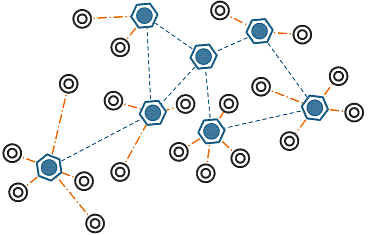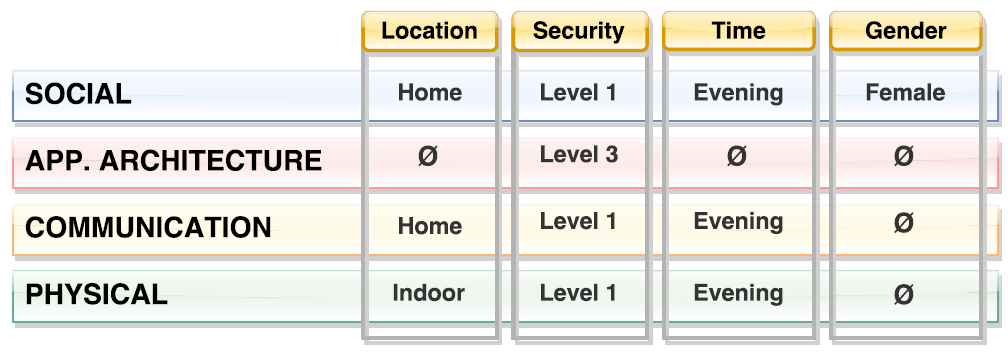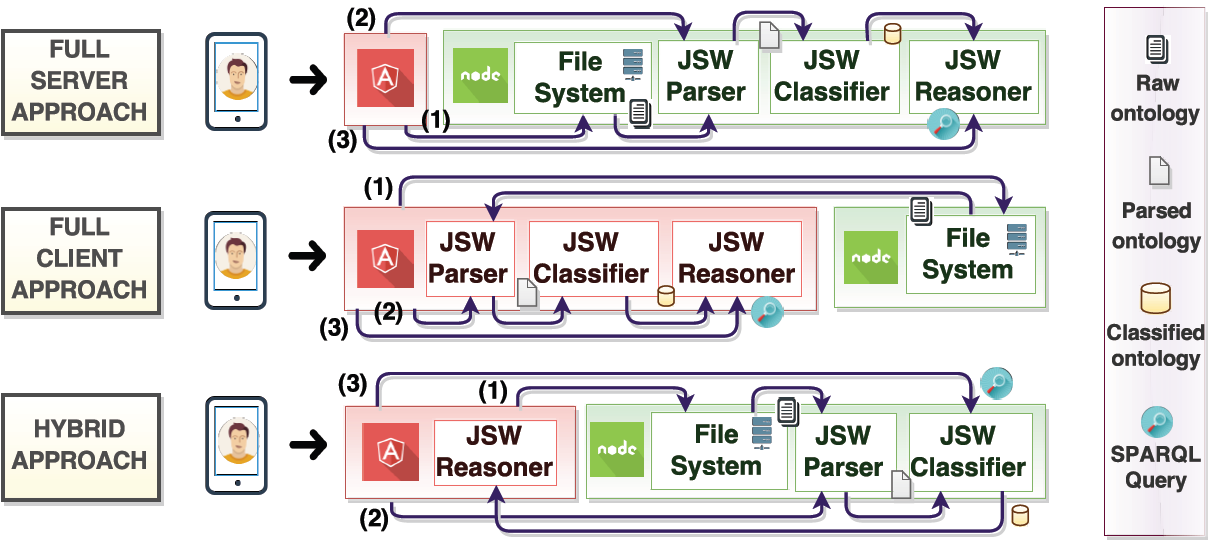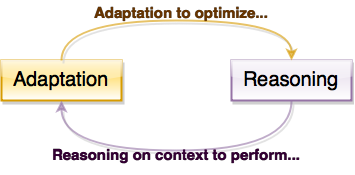Multi-level context adaptation in the Web of Things
Mehdi Terdjimi - SOC & TWEAK TeamLIRIS - Université Lyon 1
http://liris.cnrs.fr/~mterdjim/slides_presentation
At first, the Internet of Things
 |
 source: http://nwavetec.com/technology/the-internet-of-things/ |
Then, the Web of Things
- Built upon the IoT
- Relies on Web technologies and standards
- Breaks through silos
Context in ubiquitous computing
- high impact to the application's behavior
- complex and highly dynamic
How to design generic context models...
- to include what is needed by the application ?
- to do the actual adaptation, specific to the application ?
The answer is...
Multi-level context models
Context of the work: ASAWoO
- Exposing physical objects through a web interface: avatar (Mrissa et al., 2014)
- Using context to deal with resource-constrained objects.
Challenges
- Interoperable context data sources
- Generic context models
- Scalability in view of the high numbers of clients
Motivations
- Semantic context models for the WoT (SotA)
- Adaptation at several abstraction levels
- Scalable adaptation engine (reasoning steps: modularization, distribution)
PLAN
- State of the art
- context modeling
- mobile/client reasoning
- Approach
- Implementation
- Evaluation
- Discussion, future work
- context modeling
- mobile/client reasoning
State of the art: context modeling
Former definitions
- Location, identity of entities, changes to entities
(Schilit and Theimer, 1994) - Physical and conceptual states of an entity
(Pascoe, 1998) - Any information that can be used to characterize the situation of an entity
(Dey et al., 1999)
What about specific applications ?
State of the art: context modeling
Physical World
Time, Location, Activity(Schilit et al., 1993), (Dey et al., 1999), (Schmidt, 2003), (Zimmermann et al., 2007)
User, Device, Geospatial, Environment
Query recommendation and auto-complete (Arias, 2008)
Location, Time, Activity, Posture, Privacy
Context-aware web browser (Coppola et al., 2010)
State of the art: context modeling
Communication
Device computing resources, Network (status, type), Distances(Gold and Mascolo, 2001), (Mascolo et al., 2002)
Context-aware adaptive routing (Musolesi and Mascolo, 2009)
User, Location, Network policy, Network capacity, Status (Wei et al., 2006)
Notion of static, dynamic network context (Raverdy et al., 2006)
State of the art: context modeling
Application architecture
Separation of the application core from the context information(Gensel et al., 2008), (Chaari et al., 2005)
Device, Location, User, Social, Environment, Time, System, Application-specific Aspect-oriented approach (Munnely et al., 2007)
Location, Device, Application, Time (group calendar), Community (group, users, roles), Process Groupware systems (Kirsch-Pinheiro et al., 2004)
State of the art: context modeling
Social Computing
User sessions: click-trough & navigation, query reformulation & specialization (ranking)(Cao et al., 2009), (Xiang et al., 2010)
Domain, User, Environment and Interaction provides context sharing between agents in MAS (Brézillon, 2003)
User, Item, Environment, Observer describes a situation in MAS (Bazire and Brézillon, 2005)
State of the art: Mobile/Client reasoning
- KRHyper (Sinner and Kleemann, 2005), FOL
- Embedded EL+ Reasoner (Grimm et al., 2012)
- Mine-ME 2.0 (Ruta et al., 2014), ALCN
- EYE (http://reasoning.restdesc.org/), FOL
- OWLReasoner (https://code.google.com/p/owlreasoner/), OWL2 EL (limited)
Approach
- 1. Semantic context model
based on the 4 abstractions levels and SotA dimensions - 2. Generate graphs from context models
SPARQL querying on graphs - 3. Reasoning steps separation & modularization
Distributed reasoning process
 "Which communication protocols can be used?"
"Which communication protocols can be used?"
(Location: home, Security: Level_1, Time: Evening)
Implementation
Modularization of OWLReasoner steps

HyLAR (Hybrid Location-Agnostic Reasoning)
(Terdjimi et al., 2015)
- Server-side as Node / Express modules
- Client-side as AngularJS services
- Client queries sent by an agnostic angular service
Evaluation
3 configurations x 3 steps x 2 ontologies
 |
|
Evaluation results
Network delays

Classification [P2] and reasoning [P3] times

- Qx: time for the query to reach the server
- Rx: time for the response to reach the client
- Px: processing time
- Times expressed in ms
Discussion
Time calculation for M users sending N queries
Server-side:
P2server +Client-side:
Hybrid:
P2server +Discussion
No optimal configuration
Parameters: Number of clients, number of queries per client, network status, ontology size

Perspectives
- Improve/replace OwlReasoner to study the impact of more complex queries
- Semantic multi-level context model to provide...
- Adaptive reasoning process based on context states (= graphs)
- Rule engine
References
-
(Schilit and Theimer, 1994) Schilit, B.N., Theimer, M.M.: Disseminating active map information to mobile hosts. Network, IEEE 8(5), 22-32 (1994) -
(Pascoe, 1998) Pascoe, J.: Adding generic contextual capabilities to wearable computers. In: Wearable Computers, 1998. Digest of Papers. Second International Symposium on. pp. 92-99. IEEE (1998) -
(Dey et al., 1999) Dey, A.K., Salber, D., Abowd, G.D., Futakawa, M.: The conference assistant: Combining context-awareness with wearable computing. In: Wearable Computers, 1999. Digest of Papers. The Third International Symposium on. pp. 21-28. IEEE (1999)
References
-
(Schilit et al., 1993) Schilit, B.N., Adams, N., Gold, R., Tso, M.M., Want, R.: The parctab mobile computing system. In: Workstation Operating Systems, 1993. Proceedings., Fourth Workshop on. pp. 34-39. IEEE (1993) -
(Schmidt, 2003) Schmidt, A.: Ubiquitous computing-computing in context. Ph.D. thesis, Lancaster University (2003) -
(Zimmermann et al., 2007) Zimmermann, A., Lorenz, A., Oppermann, R.: An operational definition of context. In: Modeling and using context, pp. 558-571. Springer (2007)
References
-
(Coppola et al., 2010) Coppola, P., Mea, V.D., Di Gaspero, L., Menegon, D., Mischis, D., Mizzaro, S., Scagnetto, I., Vassena, L.: The context-aware browser. IEEE Intelligent Systems 25(1), 38-47 (2010) -
(Arias, 2008) Arias, M.: Context-Based Personalization for Mobile Web Search. Context pp. 33- 39 (2008) -
(Gold and Mascolo, 2001) Gold, R., Mascolo, C.: Use of context-awareness in mobile peer-to-peer networks. In: Distributed Computing Systems, 2001. FTDCS 2001. Proceedings. The Eighth IEEE Workshop on Future Trends of. pp. 142-147. IEEE (2001)
References
-
(Mascolo et al., 2002) Mascolo, C., Capra, L., Emmerich, W.: Mobile computing middleware. In: Advanced lectures on networking, pp. 20-58. Springer (2002) -
(Musolesi and Mascolo, 2009) Musolesi, M., Mascolo, C.: Car: context-aware adaptive routing for delay-tolerant mobile networks. Mobile Computing, IEEE Transactions on 8(2), 246-260 (2009) -
(Wei et al., 2006) Wei, Q., Farkas, K., Prehofer, C., Mendes, P., Plattner, B.: Context-aware handover using active network technology. Computer Networks 50(15), 2855-2872 (2006)
References
-
(Gensel et al., 2008) Gensel, J., Villanova-Oliver, M., Kirsch-Pinheiro, M.: Modèles de contexte pour l'adaptation à l'utilisateur dans des systèmes d'information web collaboratifs. In: Workshop from "8èmes journées francophones". Sophia-Antipolis, France. pp. 5-16 -
(Chaari et al., 2005) Chaari, T., Laforest, F., Flory, A., Einstein, A.A., Cedex, V.: Adaptation des applications au contexte en utilisant les services web. Proceedings of the 2nd French-speaking conference on Mobility and uibquity computing - UbiMob '05 pp. 3-6 (2005) -
(Munnely et al., 2007) Munnelly, J., Fritsch, S., Clarke, S.: An aspect-oriented approach to the modularisation of context. In: Pervasive Computing and Communications, 2007. PerCom'07. Fifth Annual IEEE International Conference on. pp. 114-124. IEEE (2007)
References
-
(Kirsch-Pinheiro et al., 2004) Kirsch-Pinheiro, M., Gensel, J., Martin, H.: Representing context for an adaptative awareness mechanism. In: Groupware: Design, Implementation, and Use, pp. 339-348. Springer (2004) -
(Cao et al., 2009) Cao, H., Hu, D.H., Shen, D., Jiang, D., Sun, J.T., Chen, E., Yang, Q.: Context-aware query classification. Acm Sigir 106(3), 3 (2009) -
(Xiang et al., 2010) Xiang, B., Jiang, D., Pei, J., Sun, X., Chen, E., Li, H.: Context-aware ranking in web search. Sigir 2010 p. 451 (2010)
References
-
(Brézillon, 2003) Brézillon, P.: Representation of procedures and practices in contextual graphs. The Knowledge Engineering Review pp. 1-26 (2003) -
(Bazire and Brézillon, 2005) Bazire, M., Bréezillon, P.: Understanding context before using it. Modeling and using context (2005) -
(Terdjimi et al., 2015) Terdjimi, M., Médini, L., Mrissa, M.: HyLAR: Hybrid Location-Agnostic Reasoning. In: ESWC Developers Workshop 2015. pp. 1-6. Portoroz, Slovenia (May 2015) -
(Mrissa et al., 2014) Mrissa, M., Médini, L., Jamont, J.P., Le Sommer, N., Laplace, J.: An avatar architecture for the web of things (2014)
References
-
(Grimm et al., 2012) Grimm, S., Watzke, M., Hubauer, T., Cescolini, F.: Embedded EL+ reasoning on programmable logic controllers. In: The Semantic Web - ISWC 2012, pp. 66-81. Springer (2012) -
(Kollia and Glimm, 2014) Kollia, I., Glimm, B.: Optimizing sparql query answering over owl ontologies. arXiv preprint arXiv:1402.0576 (2014) -
(Médini et al., 2013) Médini, L., Bâcle, F., Nguyen, H.D.T.: DataConf: Enriching conference publications with a mobile mashup application (May 2013), http://liris.cnrs.fr/publis/?id=6032, lIME'2013 Workshop at WWW'2013 conference
References
-
(Ruta et al., 2014) Ruta, M., Scioscia, F., Loseto, G., Gramegna, F., Ieva, S., Di Sciascio, E.: Mini- me 2.0: powering the semantic web of things. In: 3rd OWL Reasoner Evaluation Workshop (ORE 2014) (2014) -
(Sinner and Kleemann, 2005) Sinner, A., Kleemann, T.: Krhyper - in your pocket. In: Automated Deduction - CADE-20, pp. 452-457. Springer (2005) -
(Verborgh et al., 2014) Verborgh, R., Vander Sande, M., Colpaert, P., Coppens, S., Mannens, E., Van de Walle, R.: Web-scale querying through linked data fragments. In: Proceedings of the 7th Workshop on Linked Data on the Web (2014)
HyLAR: Hybrid Location-Agnostic Reasoning
Mehdi Terdjimi, Lionel Médini, Michael Mrissa
LIRIS - Université Lyon 1